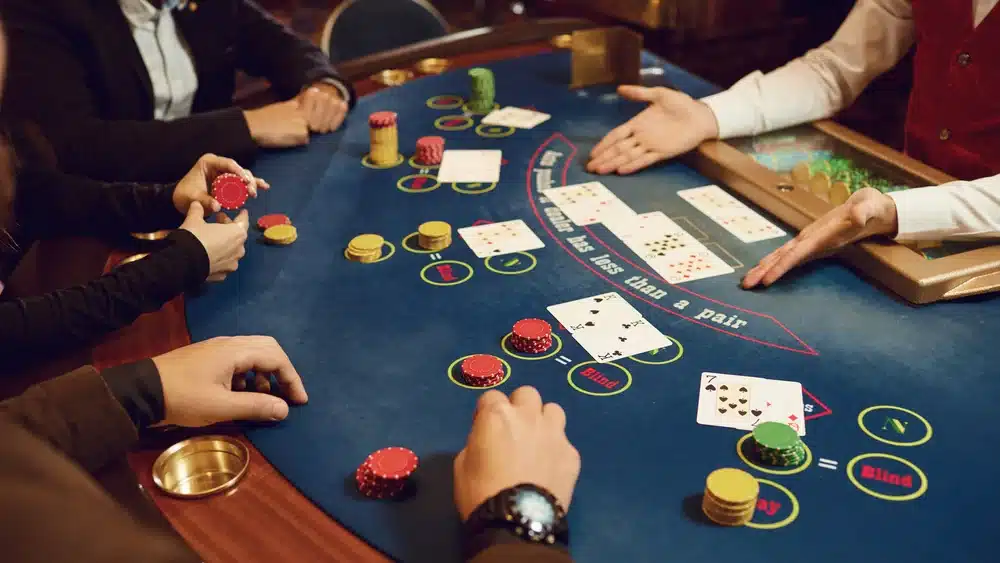Understanding D'Alembert method disadvantages for smarter gameplay The D'Alembert system is one of the most popular betting methods for roulette players who prefer a structured, cautious approach. Its appeal lies in its gradual bet increases, which feel safer than aggressive systems like the Martingale system. However, slow doesn’t always mean safe. Losing streaks, table limits, […]

Poker Check 101: Learn how to control the table like a pro
In poker, not every move needs to be bold. Sometimes the smartest play is to do nothing at all, and that is where a check comes in. It lets you stay in the hand without adding chips, keeping things calm while you plan your next move. It may seem simple, but it can shift the pace and shape the round in your favour.
A check only works if no one has placed a bet before you. It keeps the pot steady and gives you time to read the table. Whether you're holding back a strong hand or just unsure of what to do, learning when to check is vital. Learn how to break it down so you can use this quiet move like a pro.
What is a poker check?
A poker check is a move that lets you pass your turn without adding chips to the pot. It is a calm play that lets you stay in the hand but does not raise the stakes. Unlike folding, you still stay in the round, and unlike betting or calling, you risk no chips.
Here's how it works, what sets it apart, and when you can use it:
How a check works at the table
A check allows you to pass your turn when no one has bet yet. It keeps you in the hand without adding chips. The poker check action moves the turn to the next player. But if someone has already bet, you can't check and must fold, call, or raise instead.
Check vs call: Chips in play
To call, you must match the chips someone else put in. That means risk, since you need to match their bet. A check needs no chips, as no one has bet yet. Both moves keep you in the game, but one costs more.
Check vs fold: Stay or leave
A fold means you drop out and give up your hand. A check keeps you in and costs you nothing. Folding is done when you think you cannot win. Checking is done when you want to play without risk.
Poker check rules
To make the most of a poker check, you need to know when it's allowed. The rules for checking are simple, but your spot at the table and what other players do before you both matter. A check is not always an option, so it's key to know when you can use it and how it may work in each type of game.
Here are the basic rules for checking in poker:
- You can only check if no one has made a bet in that round
- If you're first to act and no bet has been made, you may check
- If all players before you have checked, you can check as well
- If someone places a bet before your turn, you cannot check
- You must then choose to call, raise, or fold instead
- In online play, the 'check' button will only show when it's allowed
Impact of player position
Where you sit at the table affects how and when you can check. If you're in an early spot, you may check only if no one has bet yet, but it comes with risk since you act first. A late position gives you the edge of seeing what others do before you move.
From a late spot, a check lets you read the table who plays safe, who bets bold, and picks a move with more thought. In early spots, you check with less info, so your play may be more of a guess than a plan.
Format-based rule consistency
The check rule stays the same across formats, as you can only check if no bet came before you. But how players use that check shifts based on the game’s pace, hand types, and risk levels.
Below are key format-based differences that affect when and why players check:
Check the logic in Omaha
Omaha gives players four hole cards, which means draw-heavy hands and higher hand strength. The more combos are in play, the more often checking aims to avoid overcommitting early. Players check more often to see free cards or dodge big bets until a draw improves. It’s less about trap play and more about control and caution.
Checking in short-handed games
With fewer players at the table (like 3 or 4), the pace is faster, and players are more aggressive. In this case, checks can still be used, but they’re more likely to get punished by bets. This makes each check carry more weight, as passive moves are more exposed. Strategic checks here often work best when used to set up a quick shift in tempo.
Check behaviour in online formats
In online poker, timing tells can mislead, so checking is more about pure play than live cues. Players often check fast due to multi-tabling or network lag. That’s why check reads in online games rely more on bet patterns and board texture than speed. The rule stays firm, but players use more logic than emotions.
Why the rule must stay consistent
A fixed check rule ensures fairness across all game types. If players could check after a bet or out of turn, it would break the structure. Keeping this rule tight means each betting round stays balanced, no matter the game speed, size, or table style. Strategy may shift, but the core rule never does.
Benefits and risks of checking in poker
Checking may seem like a quiet move, but it can help you stay in the round. It gives you a chance to watch others first, so you can plan your next step.
Here’s what you need to know:
Reading the table without risk
Checking gives a free chance to watch how others act before you make a move. This helps you plan your next step with more thought. It’s key when your hand has room to grow, like when you’re on a draw. You keep your chips safe while still in play.
Hiding strong hands for traps
When you check with a good hand, opponents might think you're weak. This sets up traps like a check-raise that catch bold bluffs. It can pull more chips into the pot without alerting them too soon. This works best with opponents who bet fast or bluff often.
Keeping pots small on weak hands
If your hand is not strong, a check helps keep the pot low. This lowers the risk if things don’t go your way at showdown. It’s a safe way to stay in the hand without bold moves, making it good for control, but not for big wins.
Missing value with top hands
When you have the best hand, a check might stop others from betting. This means you win less, even when you’re ahead. It’s a missed shot to build the pot. You must weigh pot growth versus the risk of scaring opponents off.
How the opponent may read your check
A check can be read as weak, even if that’s not true. Opponents may use that to push hard or bluff strongly. In some spots, that’s good, but in others, it can backfire. Know your foe and how they read signs.
Check the breakdown of the benefits and risks of checking in poker below:
| Benefits | Risks |
| Let you stay in hand for free | May show a weak hand to opponents |
| Helps you see what others plan to do | Gives up the chance to grow the pot |
| Can set a trap with a check-raise | May miss value if another player also checks |
| Helps keep pot small with weak or mid hand | May lose the lead in hand control |
| Fits smart plays like check-call or fold | Not fit if opponents tend to check too |
Poker check strategy
Now that you know when a check helps or hurts, you should know how smart players use it to steer the hand. Checking in poker isn't just a safe play. With good timing, it can shift how a hand unfolds. You can use it to keep the pot small, draw a bluff, or hide a strong hand. The value of a check grows when it's part of smart plays that fit your hand, spot, and even the flow of top poker variants like Texas Hold’em or Omaha.
Here are the three most-used check-based plays and how they work:
Check-raise
A check-raise starts with a check, then a raise if someone bets. It's a sharp move that makes opponents think you're weak, then hits back strong. This play works best when you’ve got a strong hand and want more chips in the pot. It can catch bluffers off guard and push mid hands to fold.
Check call
A check-call means you check first, then match a bet. It’s great when you’ve got a fair hand, like one pair or a draw, and want to see the next card. This play keeps the pot in check and avoids giving away strength. It’s best used against opponents who bet light or bluff often.
Check fold
A check-fold is used when your hand has no real value. You check first, but once someone bets, you give up the hand. It helps you stay in control and cut losses before they grow. It’s smart to use this when opponents bet big and your cards can’t catch up.
When to check in poker
In online play, it’s easy and quick to check with a tap or click, yet the reasons behind it matter more than speed. Some players try to read 'timing tells,' but long or fast checks can happen due to lag or playing many games at once. These tells are often wrong and should not guide your plan.
Here are the five key spots to know when a check works or fails:
Quick check with weak cards
When you've got no hand and miss the board, a check is a calm way to stay in without risk. It keeps the pot small and may draw checks from opponents with weak hands, too. But if someone bets right after, it may be time to fold. This is a low-risk move for hands that don't hit much.
Slow check with a strong hand
Some players take time and then check strong cards to act weak. This slow check may draw a bluff or bet from opponents who think you’ve missed. It can trap them and let you check-raise for more chips. Just don’t wait too long or it may look odd and raise red flags.
Checking on the flop after no raise
If the pre-flop play had no raise, the flop may not show strong hands yet. A check here is smart if you’ve got mid cards or want to see what others do. It helps avoid risk and gives space to plan your next move. But if all players check, the round moves fast, and weak hands stay in.
Using a check when short on time
In online play, some players check fast just to save time or focus on other games. It’s fine to use when you’ve got no plan to bet or raise, but don’t use it too much. Opponents may spot this habit and press hard with bets. Stay sharp even in fast games and make checks with care.
Checking to bait a bluff
A check can trick opponents into thinking you're weak. This works best when you’ve got a top pair or a strong draw but want them to lead. If they bite, you can call or raise and get more value. Use this move if your opponent likes to bet first and push light hands.
Try the poker check at Bitcasino
Ready to take what you've learnt to the table? Bitcasino gives you a real way to use the check, move with care and skill. It's one thing to read about it, but real games teach much more. You can try slow hands, trap moves, or low-risk turns without risk to your pace or play style.
A trusted gaming platform that offers crypto used like Bitcasino, lets you play smart while still in full control. You pick when to sit, when to check, and when to fold or call. That makes it a fine spot to test what works and what does not. Use each hand as a step to grow your game.
Frequently Asked Questions (FAQs)
What is a check in poker, and when can I use it?
A check is when you pass your turn without adding chips to the pot. You can only check if no one has bet before you in that round. If someone bets, you're no longer allowed to check.
How do experienced players use checking strategically in online poker?
Skilled players use checks to control the pot size, lure bluffs, or see free cards. It helps mask hand strength and lets them act based on what others do. In online games, it's part of a wider plan, not just a pause.
Can checking too often be a mistake in online poker?
Yes, it can give away control or make you look weak. This may lead bold opponents to bet hard and push you out. It also wastes chances to build the pot when you have a strong hand.
Can I check at any time during a poker hand?
No, you can only check when no one before you has made a bet in the current round. If a bet is on the table, you must fold, call, or raise. Timing and position matter.
Does table position affect when I can check?
Yes, players in early spots act with less info and may check to stay safe. Those in late spots often gain more insight and can plan their check better. Table spot plays a key role in how smart your check can be.
Is checking different in Texas Hold’em and Omaha?
The rule to check stays the same in both games; you can only check if no one has bet. However, how and when to check shifts due to how hands play out. Omaha often has more draws, which may change check use.
Can I use check-raise in online poker?
Yes, it’s a smart move used to trap opponents who bet after you check. You act weak, then come back with a strong raise. It works best when used with strong hands.
What happens if everyone checks in a round?
If all players check, the round ends and the next card is dealt or the hand moves on. No chips are added to the pot. It's a sign that no one wants to bet or show strength.
Can I use a poker check action to bluff in online poker?
Yes, you can use a poker check action to look weak and tempt an opponent to bet. This works well if you plan to raise after, or if you're holding a strong draw. It's a way to steer the hand without showing your true strength too soon.
Recent Post
Self-Hyena method and its strong impact on casino strategy The Self-Hyena method has become a growing topic of discussion in casino strategy circles. Often described as a hybrid approach to betting, it attracts attention as it relies less on pure chance. You are relying more on keen observation, timing, and discipline with the Self-Hyena method, […]
Poker kicker guide: Learn the key rules before you play In poker, knowing the rank of your hand is not enough to judge if you will win. A kicker plays a huge role in close hands where two or more players share the same main rank, such as a pair or two pairs. The poker […]

Actual payout amounts will vary depending on the currency you use.















